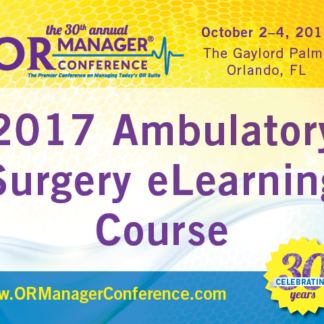Description
This package includes ASC sessions from the 2022 OR Manager Conference. Earn 6 contact hours upon completion of a post-test.
Presentations include:
- Patient Selection and Extended Recovery Options in the ASC
- Is Your ASC Ready for a Compliance Audit?
- Infection Prevention Surveillance and Data Collection in the ASC, Part I
- Infection Prevention Surveillance and Data Collection in the ASC, Part II
- Don’t Forget Me! Commit to Sit for the Outpatient Population
- Transitioning Surgical Outpatients to the Ambulatory Environment
Learn more about the sessions:
Patient Selection and Extended Recovery Options in the ASC
The ambulatory surgery center (ASC) relationship to inpatient hospitals can be challenging when it comes to operational decisions. Patient location, block time assignment, and start times (whether inpatient or outpatient) are only a few decisions among a mirage of others to consider when making an ASC profitable. ASCs provide quality care at a reduced cost while achieving high rates of employee and patient satisfaction. Bumped to the top of the list while we navigate COVID-19 is system strategy to liberate inpatient OR time for high acuity patients by assignment of lower acuity patients to satellite ambulatory locations. To accomplish this, the need was identified to shift outpatient procedures from inpatient venues to ambulatory sites. To support this need, the operationalization of an extended recovery unit (ERU) located inside a licensed ASC was developed. This presentation will show the ASC ERU model, patient population, management, inpatient impact post-implementation, and lessons learned.
Is Your ASC Ready for a Compliance Audit?
Ambulatory surgery center (ASC) regulatory compliance may seem daunting for many managers. ASC staff working to achieve compliance must stay on top of the specific regulations impacting ASCs. Attend this session to get the latest updates on Medicare surveys, new regulations and options for compliance.
Infection Prevention Surveillance and Data Collection in the ASC, Parts I & II
The ambulatory surgery infection preventionist (IP) performs vital surveillance and data collection. It is important for the IP to conduct regular audits of infection prevention area such as hand hygiene, safe injection practices, and cleaning and disinfection. If a post-operative surgical site infection is identified, the IP must develop a plan to complete a thorough investigation and use data to identify trends. This presentation will describe how to prioritize the infection prevention surveillance focus areas in the ambulatory surgery center (ASC). This will include a review of sample audit tools and a surgical site infection investigation form. It will conclude with communication of surveillance findings to healthcare workers, regulatory agencies, and the governing body of the ASC.
Don’t Forget Me! Commit to Sit for the Outpatient Population
The goal of “Commit to Sit” is to increase patient satisfaction and nurse-patient communication. The commit to sit initiative will strive to increase OASCAPS scores in the discharge section, while decreasing negative comments about the discharge process during post-op day 1 follow up phone calls.
According to feedback from patients regarding discharge instructions during routine post-op phone calls, the need to improve the overall experience in the same day procedure area was critical to improving patient satisfaction. The phrases used by patients most frequently were ” I felt the nurse was rushing me” or ” I felt the nurse failed to review important information for my discharge plan. ” This potentially could impact 20 patients per day.
Compliance on reviewing discharge instructions varied. The commit to sit project was presented to the unit council and staff nurses were asked to voice their concerns and note any potential barriers to completing the project. Chairs were purchased for easy access for staff. Patient care techs were instructed to answer phones while nurses were committing to sit. Education was completed on all staff members by unit council members.
Data was collected from post op day 1 follow up phone calls, patients answered two survey questions. Bulletin boards were incorporated to explain to patients the project as well as the results of the data collected was placed for staff to see. The survey conducted among the staff nurses revealed a 73% favorable for the project to increase patient’s understanding while an 85.7% favorable it would enhance the overall hospital experience.
The 2-question survey collected from patients over a course of 17 weeks and revealed 94.5% overall that the project was being completed and it enhanced the overall hospital experience for the patient. Feedback from patients during the post-op phone calls conducted by the registered nurses in same day procedure unit revealed rare complaints of “feeling rushed” or “unprepared” after discharge since Commit to sit was implemented.
As the project continued the compliance of the nurses increased. Patients and staff found an overall improvement in the hospital experience based upon the data. Nurse compliance and engagement increased from staff to improve the patient’s experience in the department increased. Patient’s perception of nurse’s compassion to their wellbeing had been restored.
Transitioning Surgical Outpatients to the Ambulatory Environment
Escalating costs in today’s perioperative environment are a significant concern, undermining the financial viability of many hospitals amid the COVID pandemic. Hospitals are facing extraordinary challenges effectively balancing the cost of clinical care, managing escalating medical supply costs, and addressing capacity issues with higher acuity and increased co-morbidities among patients than ever before. Creating a multifaceted approach to address these issues requires “all hands on deck” and with innovative and integrated solutions lead collectively by nurses, physicians, and hospital administrators. Effective cost management strategies in the perioperative environment require a strong foundation to ensure quality patient care outcomes remain at the forefront while effectively managing the cost of care.
Attend this session to learn methodologies to effectively transition elective outpatient procedures from a traditional inpatient OR environment to an ambulatory setting.



